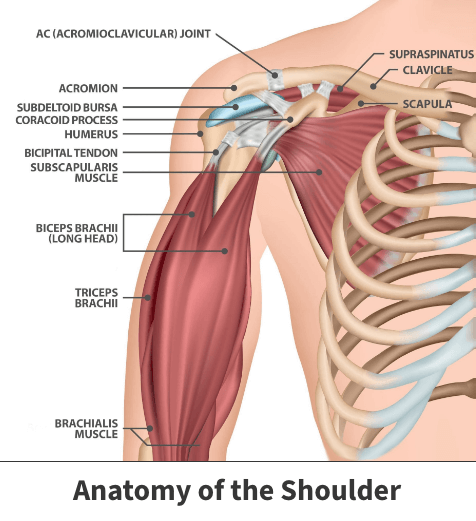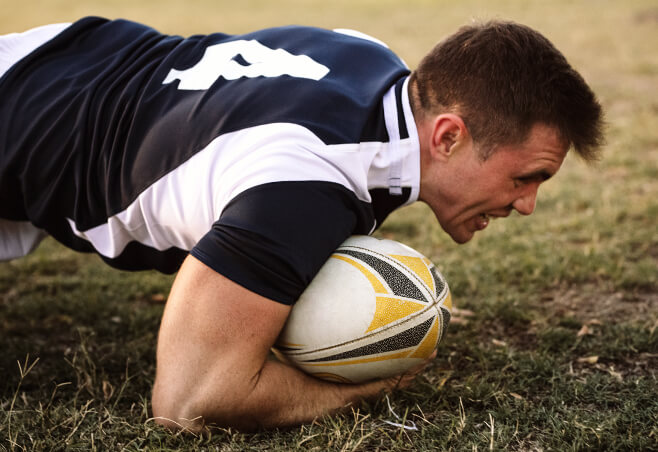Separated shoulder
Your shoulders are essential parts of your body. They allow you to have wide arm motions, lift objects, and perform almost every activity involving your upper body.
The pressure your shoulders carry increases their risk for developing various injuries. One common injury is called a shoulder separation.
Anatomy

The shoulder is made up of many bones, muscles, and soft tissues like ligaments. These solid and flexible materials connect your shoulder to other important nearby parts.
About
One adjacent part of your shoulder anatomy is the collarbone. Ligaments of the AC joint connect your shoulder blade (the scapula) to the collarbone. The connection of parts plays a significant role in helping you move your arm.
Shoulder separations happen when these ligaments become damaged. These injuries are graded based on their severity:
- Grade 1 – Grade 1 events are considered the most minor and occur when ligaments are stretched but not torn. These do not involve any movement or damage to the collarbone.
- Grade 2 – Grade 2 events involve slight ligament tears. In these injuries, the collarbone may experience minor movement shifts.
- Grade 3 – Grade 3 tears are the most serious. Ligaments suffer severe, quite possibly complete tears, and the collarbone experiences a noticeable position shift.
Causes
Shoulder separations can result from several causes.
The most common cause of an immediate and acute injury is a severe fall or accident where significant pressure is placed on the shoulder and its neighboring parts.
Shoulder injuries may also occur gradually from repeated shoulder-stressing actions in professional or recreational settings.
Risk factors
Your chances of developing a non-traumatic shoulder separation increase with:
- Playing physical, contact sports (football, rugby, or hockey).
- Activities where falls are more likely to occur (skiing, gymnastics, and cycling).
- Age – Researchers have discovered that shoulder sprains occur more frequently in teens and young adults.
- Having a previous or pre-existing shoulder problem.
Gender can also be a factor as men seem to stand at greater risk than women.

Symptoms
The symptoms you experience can vary depending on the separation’s severity. Most produce common symptoms like:
- Bruising or inflammation on or around the shoulder
- Pain in the shoulder and upper arm
- Visible lumps on the shoulder or near the collarbone
- Mobility issues
More severe cases could lead to a popping sound or sensation when moving the affected shoulder and numbness in the hand or fingers.
Complications
If not properly diagnosed and treated, shoulder separations can worsen and result in more problems. Some of these complications include damage to nerves, the need for more aggressive treatment, the development of diseases like arthritis, and permanent disability.
Diagnosis
Your doctor will first conduct a thorough examination of your shoulder and look for any obvious visual abnormalities. Afterward, you may be requested to perform various exercises designed to measure your pain threshold and range of movement.
Unsurprisingly, a diagnosis is easier to confirm when the injury is more advanced. This is because moderate to severe separations produce obvious signs like deformities. X-rays and MRI scans are used to help determine treatment options.
Mild separations often need imaging scans because they typically do not produce many outward signs. Doctors sometimes ask patients with suspected Grade One separations to hold heavy objects in their hand during shoulder X-rays. This technique may increase shoulder instability, which often appears on imaging scans.
Treatment
The severity of the separation is the most significant deciding factor when considering shoulder separation treatment. Your doctor will also weigh other issues, including your:
- Age
- Fitness level
- General health
- Shoulder’s structural makeup
- Weight
In many instances, mild to moderate injuries improve over time without aggressive treatment. Severe damage may need surgery.
Nonsurgical treatments
The pain associated with mild injuries may be relieved using home therapies, such as ice packs, over-the-counter pain-reducing medications, or putting the injured shoulder and arm into a sling. Avoid any heavy lifting until significant healing has taken place.
More moderate separations may also benefit from a period of physical therapy. In your treatment plan, you will carry out specially designed exercises geared towards helping your shoulder regain any lost strength or motion range.
Uncomplicated injuries should heal completely within two to 12 weeks.
Surgical treatments
You may benefit from surgery if you have severe injuries involving:
- Major ligament damage
- Collarbone shifting
- Potentially disabling symptoms (hand or finger numbness)
- Major mobility limitations
- Damage to nerves or other neighboring body parts
One commonly performed procedure includes the trimming of the collarbone. This operation prevents the collarbone from coming into contact with the shoulder blade. In another procedure, doctors reattach damaged ligaments to the collarbone. Most surgeries will likely be followed by several weeks of physical therapy.
Post-surgical recovery time frames vary because every patient heals at their own pace.
Videos
Related specialties
- AC Joint Injuries
- Atraumatic Shoulder Instability
- Bankart Repair
- Bicep Tenodesis
- Broken Collarbone
- Bursitis of the Shoulder (Subacromial Bursitis)
- Calcific Tendinitis of the Shoulder
- Clavicle Fractures
- Dislocated Shoulder
- Fractures of the Shoulder Blade (Scapula)
- Glenoid Labrum Tear
- Impingement Syndrome of the Shoulder
- Little League Shoulder
- Reverse Total Shoulder Replacement
- Rheumatoid Arthritis (RA) of the Shoulder
- Rotator Cuff Tears
- Shoulder Arthritis
- Shoulder Arthroscopy
- Shoulder Injury: Pain in the Overhead Athlete
- Shoulder Replacement
- Shoulder Socket Fracture (Glenoid Fracture)
- SLAP Tears & Repairs
- Subacromial Decompression
- Trapezius Strain (Muscle Strain Of The Upper Back)
- Traumatic Shoulder Instability
